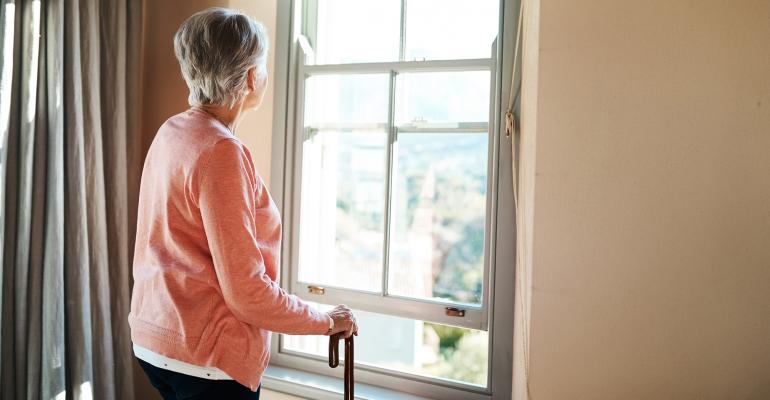Rising interest rates and pressure on NOI are contributing to expectations for higher cap rates ahead in the seniors housing sector, according to respondents in the ninth annual WMRE / NIC Seniors Housing Survey.
A majority of respondents (71 percent) think seniors housing cap rates will increase over the next 12 months, while 11 percent anticipate no change and 18 percent believe cap rates could decrease. Expectations for rising cap rates have moved slightly compared to the 65.5 percent who held that view in the 2021 survey. However, respondents are expecting the overall change to be modest—an increase of 51 basis points, less than the expected rise in interest rates by economists.
In addition, some market participants argue that cap rates as applied to in-place income have been a more difficult market barometer with many properties that are battling near-term NOI challenges due to high inflation and lingering effects of COVID on occupancies. Instead, investors are focusing on other factors, such as per bed and per unit pricing, drivers of value, and top-line revenue, notes Ben Firestone, CEO and co-founder of Chicago-based Blueprint Healthcare Real Estate Advisors.
“Investors are stretching out their investment period and looking to other metrics than where cash flows are today at a static cap rate,” he says.
Pricing trends vary widely depending on the asset. For example, Blueprint recently closed on a single-private-pay seniors housing asset with 60 percent occupancy for a cap rate of approximately 5.95 percent on projected year-two EBITDAR (earnings before interest, taxes, depreciation, amortization, and rent.) At the time of sale, the in-place EBITDAR was only marginal. However, prices continue to soar for those types of assets in good growth markets, which is driven in part by higher replacement costs, notes Firestone. “The investors that are the most aggressive in bidding are the ones that are willing to be patient and have a multi-year strategy,” he says.
Lloyd Jones LLC, a firm that invests in multifamily and seniors housing, is targeting acquisitions with cap rates ranging between 6.5 and 9 percent. “We’re also seeing a lot of negative cash flow deals. So, it’s hard to put a cap rate on some of those deals,” notes Padron. In particular, Lloyd Jones is looking to buy value-add assets at $70,000 to $80,000 per door. There were a number of operators that were hit hard by COVID and have yet to come out of it, he says. “That’s where we think we can come in at value and take properties over and turn things around,” he adds.
Rent growth also could help shore up cap rates. Annual rental rates rose across NIC MAP’s Primary Markets by 3.3 percent in first quarter, and a majority 93 percent expect rents to increase further over the next 12 months. Overall, the average expectation is an increase of 304 basis points. Sentiment is more positive than in the 2021 survey where 87 percent of respondents thought rents would rise by an average of 261 basis points.
“While operational challenges are a factor, investors are accounting for those challenges accordingly. Spreads/yields continue to be attractive and the intermediate to longer-term outlooks look robust,” says Sweeney. “Given seniors housing has performed well during previous recessionary cycles, capital continues to be interested in putting dollars to work in the sector in the right locations.”
Investors are concerned that access to both debt and equity could be more limited in the coming year. Nearly half of investors (53 percent) believe debt will be more difficult to access over the next 12 months. Fears are not as great as in 2020 when 57 percent thought access to debt would tighten, but it is significant that those views on more limited debt are at the second-highest level in the history of the survey. Opinions on access to equity also are more pessimistic. Roughly one-third of respondents (32 percent) said access to equity could be tighter over the next 12 months. Similar to debt, 2020, views on less availability of equity ahead are the second-highest level in the history of the survey.
That being said, a majority of respondents do think equity will remain the same (45 percent) or improve (23 percent.) “There is an abundance of capital that has been raised that these institutional groups need to put to work,” says Cary Tremper, managing director and head of Senior Housing Capital Markets at Greystone. “I wouldn’t say that everyone has the same access to capital across the board, but typically for the ones that have the ability to execute and have the track record, capital is there on the equity side,” he says.
The full research results will be featured in a webinar taking place July 19, 2022. Join Chuck Harry, NIC’s Chief Operating Officer, and Beth Mace, NIC’s Chief Economist as they discuss the results of the 2022 WMRE/NIC Investor Sentiment Survey, review the latest trends data, and revisit the investment thesis for this property sector as we emerge from the COVID-19 pandemic. Register here.
In addition, a full version of the seniors housing market research will be published later this week.
Survey methodology: The WMRE / NIC research report on the seniors housing sector was conducted via an online survey distributed to WMRE readers in June. The 2022 survey results are based on responses from 208 participants. The majority of respondents hold top positions at their firms with 43 percent who said they were either an owner or C-suite executive. Respondents also represent a cross-section of different roles in the seniors housing sector, including investors, lenders, developers, brokers and owner/operators.





